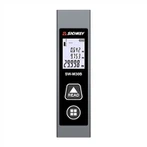Spirit Levels - Main Types
1. Sprit levels
The bubble level is a measuring instrument to check whether the machine installation surface or plate is level, and to measure the direction of inclination and the size of the angle. Its shape is made of high-grade steel. There is a long and curved glass tube in the center, and there is also a horizontal small horizontal glass tube at the left end. The tube is filled with ether or alcohol, and there is a small bubble, which is always at the highest point in the tube. There are scales on both ends of the bubble on the glass cylinder. Usually, when the machine is installed in the factory, the sensitivity of the commonly used bubble level is 0.01mm/m, 0.02mm/m, and the sensitivity of the bubble level is 0.04mm/m, 0.05mm/m, 0.1mm/m, 0.3mm/m and 0.4mm/m, etc. Specifications, that is, place the level on a 1-meter-long straight rule or plate. When one of the endpoints has a sensitivity indicating the difference in size, if the sensitivity is 0.01 mm/m, it means that the two ends of the straight rule or plate have A height difference of 0.01 mm (equivalent to a difference of 2 seconds between the two ends), when the height difference of h mm is 1 m long, the bubble will have a difference of one scale. The principle of the bubble level is to use the bubble in the glass tube, and the bubble can always be kept at the highest position
For a certain inclination angle, if you want to increase the movement of the bubble (that is, the so-called good sensitivity), you need to increase the arc radius (R). If the distance per scale of the level meter is 2 mm and the sensitivity is 0.01 mm/m, the difference between the two ends of 1 m is 2 seconds. That is, the radius of the bubble tube is 206.185 meters, and it is installed in the frame. Different sensitivities have different radii, and there is no direct relationship with the length of the frame.
When using a level, you should check first. Put the level on the flat plate and read the scale of the bubble, then turn the level upside down and place it in the same position, and then read the scale. If the readings are the same, it means that the base of the level is connected to the bubble tube. The relationship between is correct. Otherwise, it is necessary to use the fine-tuning screw to adjust until the readings are exactly the same before making the measurement. If you want to check the accuracy of the level, you can use the known angle size composed of the sine rod and the gauge block. At the same time, if you want to measure a large inclination angle, you can also use it together with a sine rod and a level.
As a substitute for the traditional bubble-type inclination, the new-style spirit level is now more used in road engineering, mechanical measurement, construction engineering, industrial platforms, oil exploration, j military, ships, and others that require inclination or level under the gravity reference system Condition.
2. Electronic levels
Electronic level, it is used to measure high-precision machine tool, such as NC lathe, milling machine, cutting machine, three-dimensional measuring bed and other bed surfaces, its sensitivity is very high, if it can be calculated by shifting 25 scales left and right during measurement, the measurement The workpiece can only be measured within a certain range of inclination. Frame electronic level
There are two main principles of electronic levels: inductive and capacitive. According to different measurement directions, it can also be divided into one-dimensional and two-dimensional electronic levels.
Inductive principle: When the base of the level is tilted due to the inclination of the workpiece to be measured, the voltage of the induction coil will change due to the movement of the internal pendulum. The measurement principle of the capacitive level is that a circular pendulum hangs freely on a thin wire. The pendulum is affected by the gravity of the center of the earth and is suspended in a frictionless state. There are electrodes on both sides of the pendulum and the capacitance is equal when the gap is the same. If the level is affected by the workpiece to be measured, the different distances between the two gaps will produce different capacitances and angle differences.





